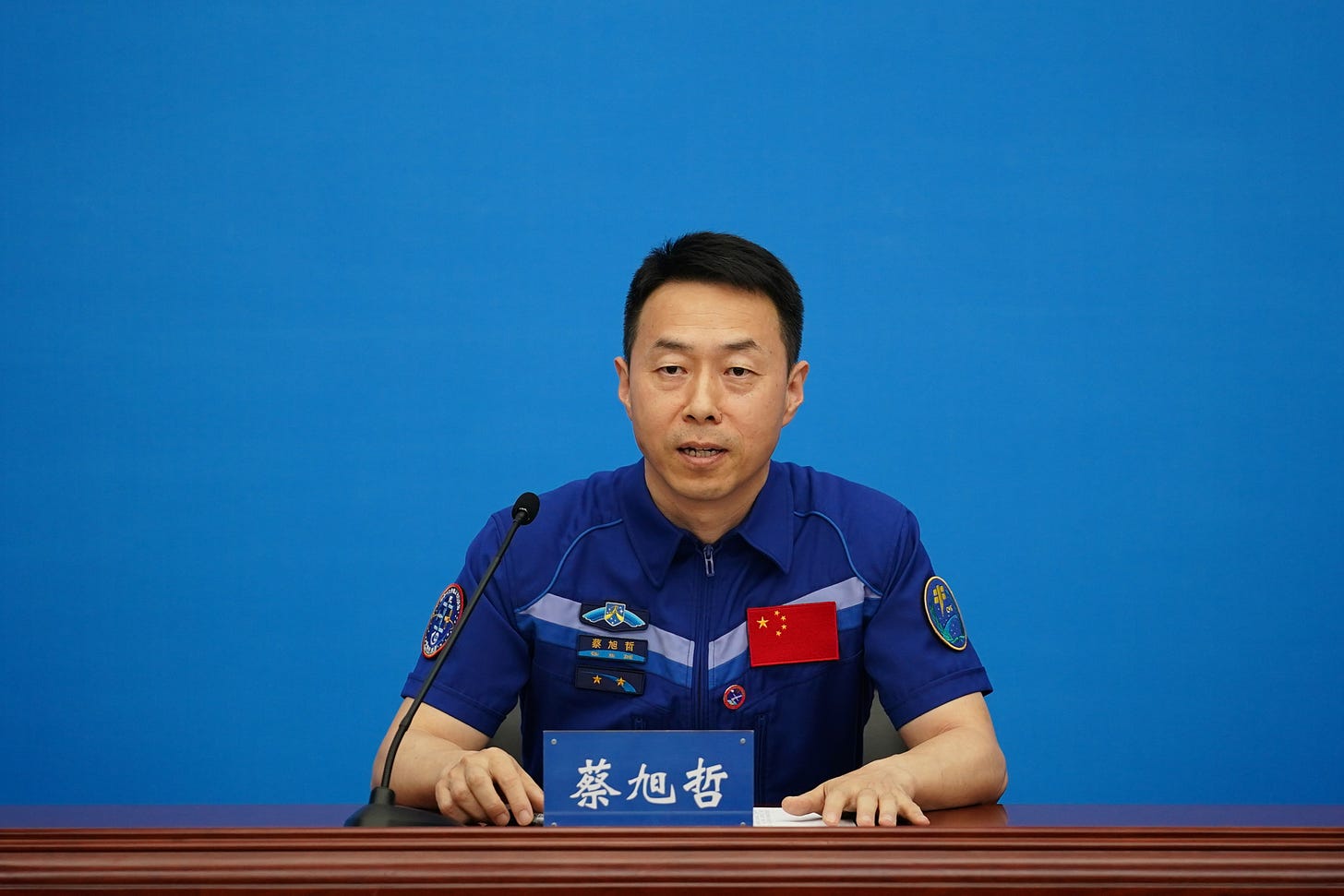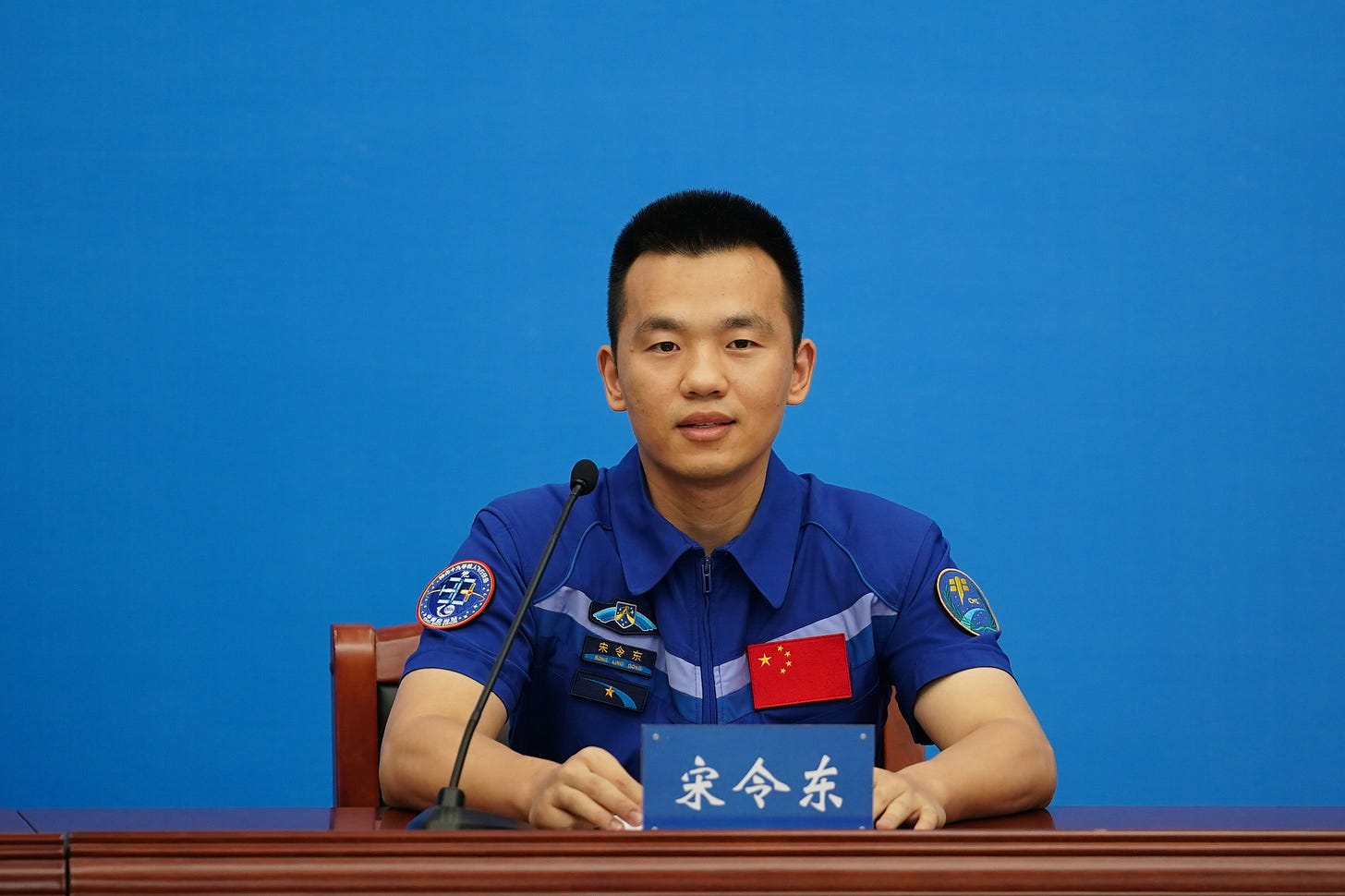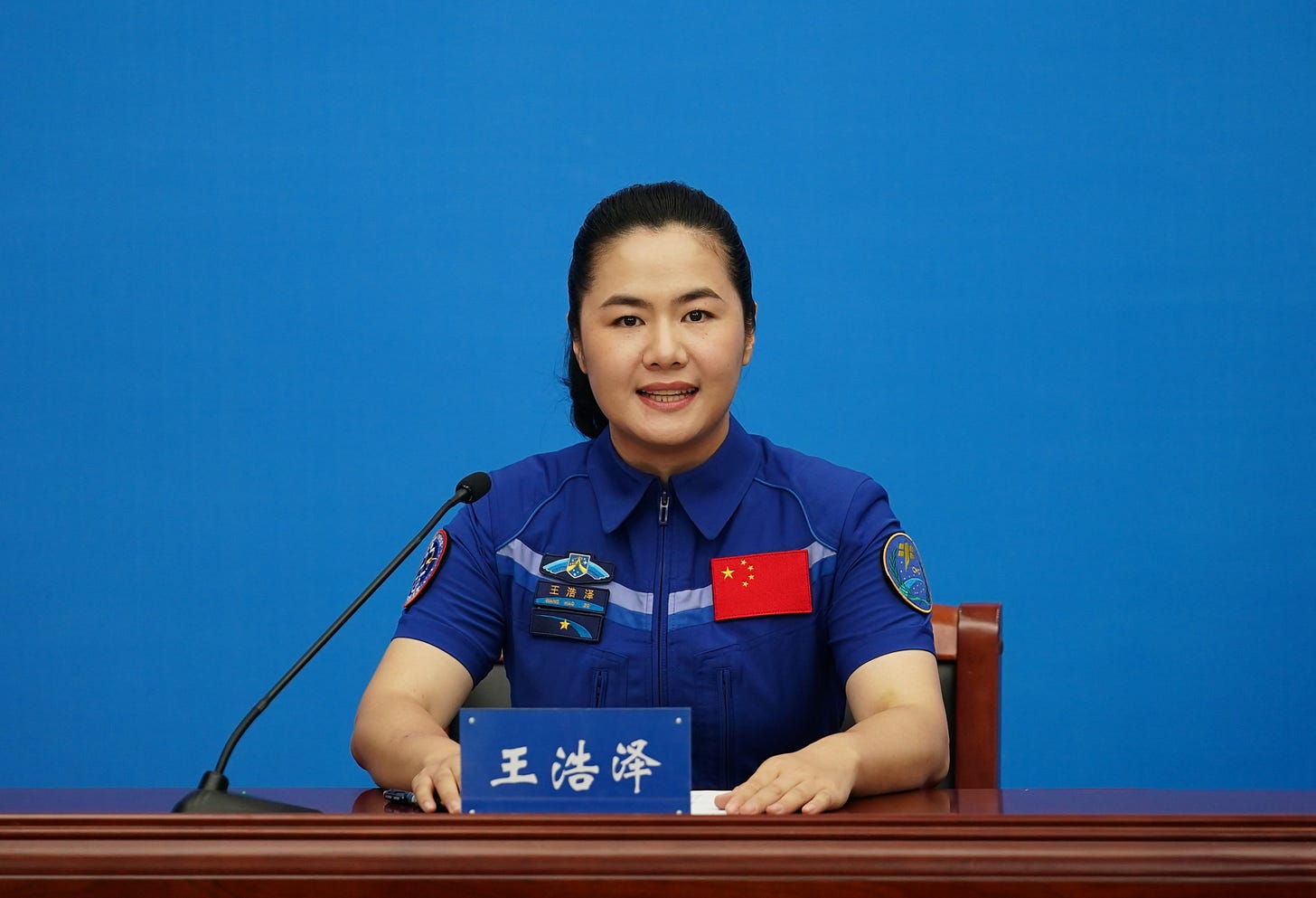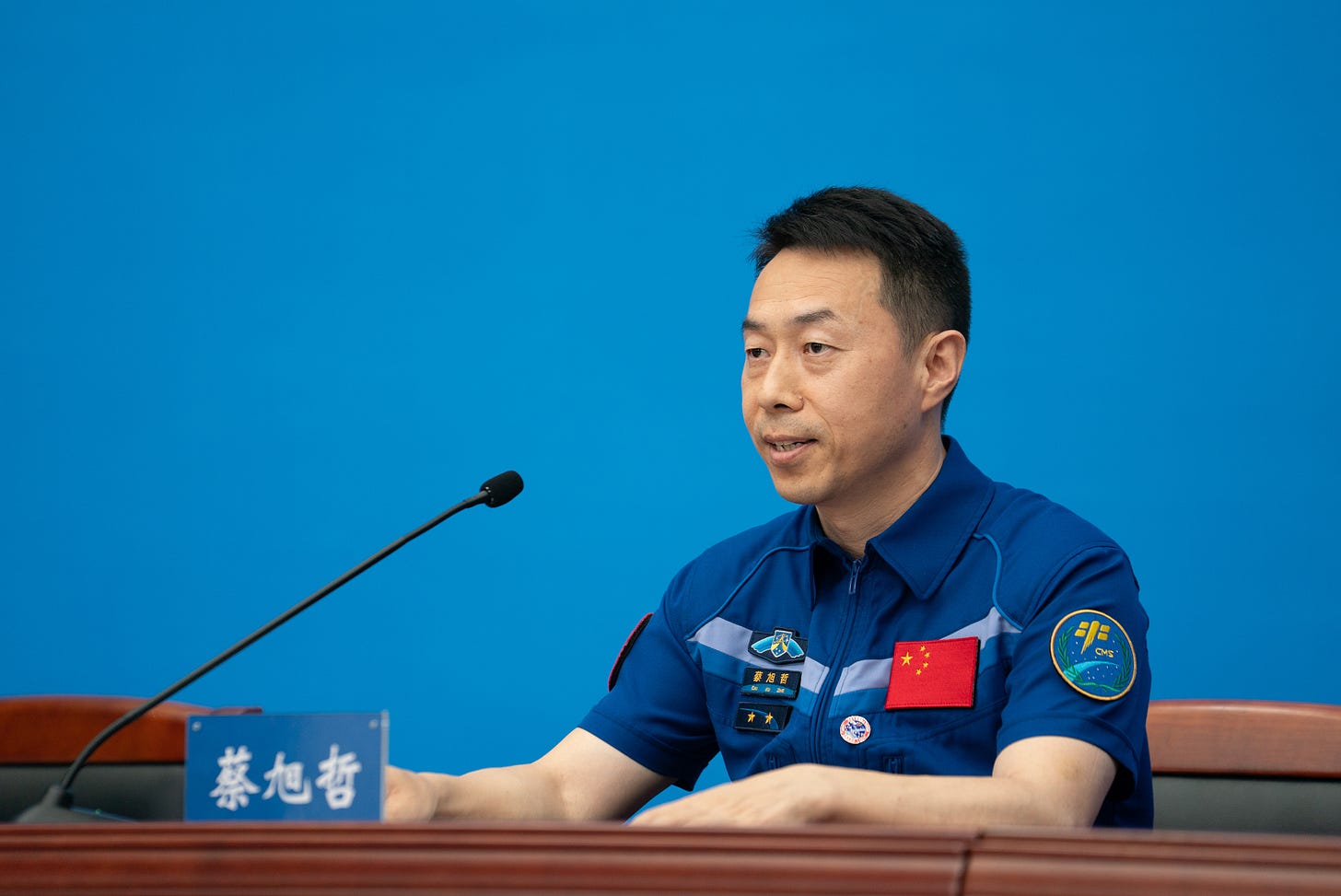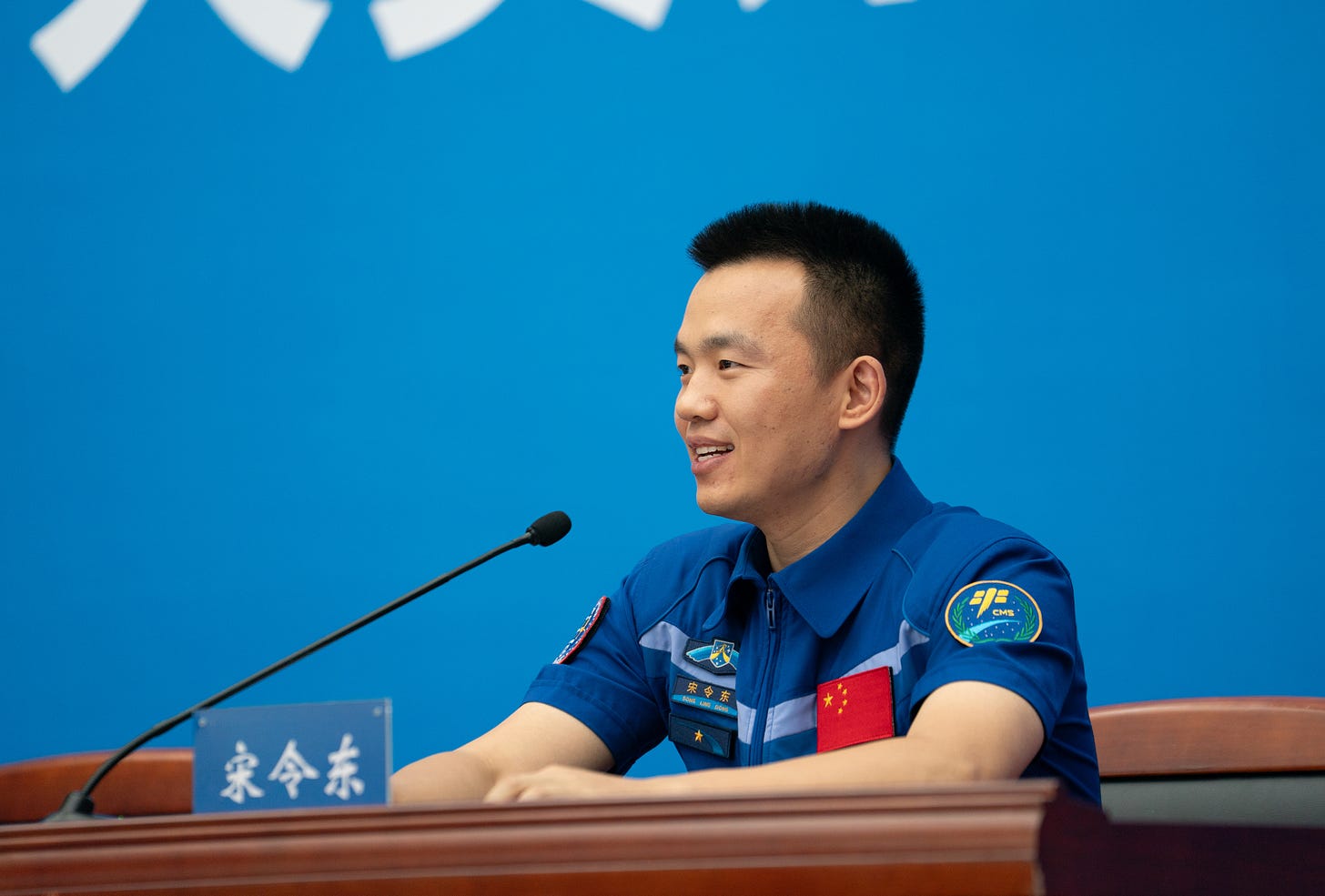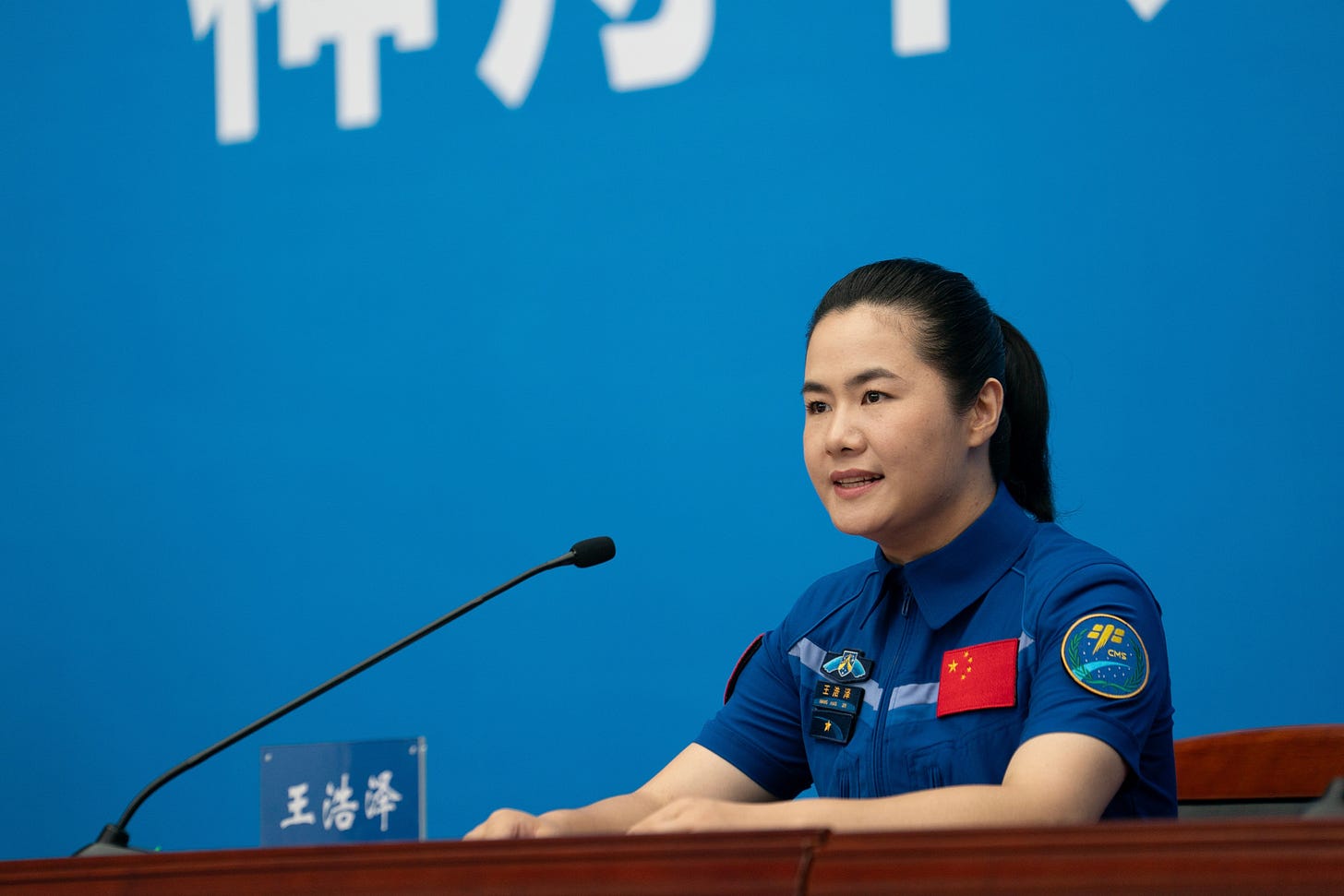Shenzhou-19 Crew Discuss Their Six-Month Mission
Spacewalks, science, and the Earth below.
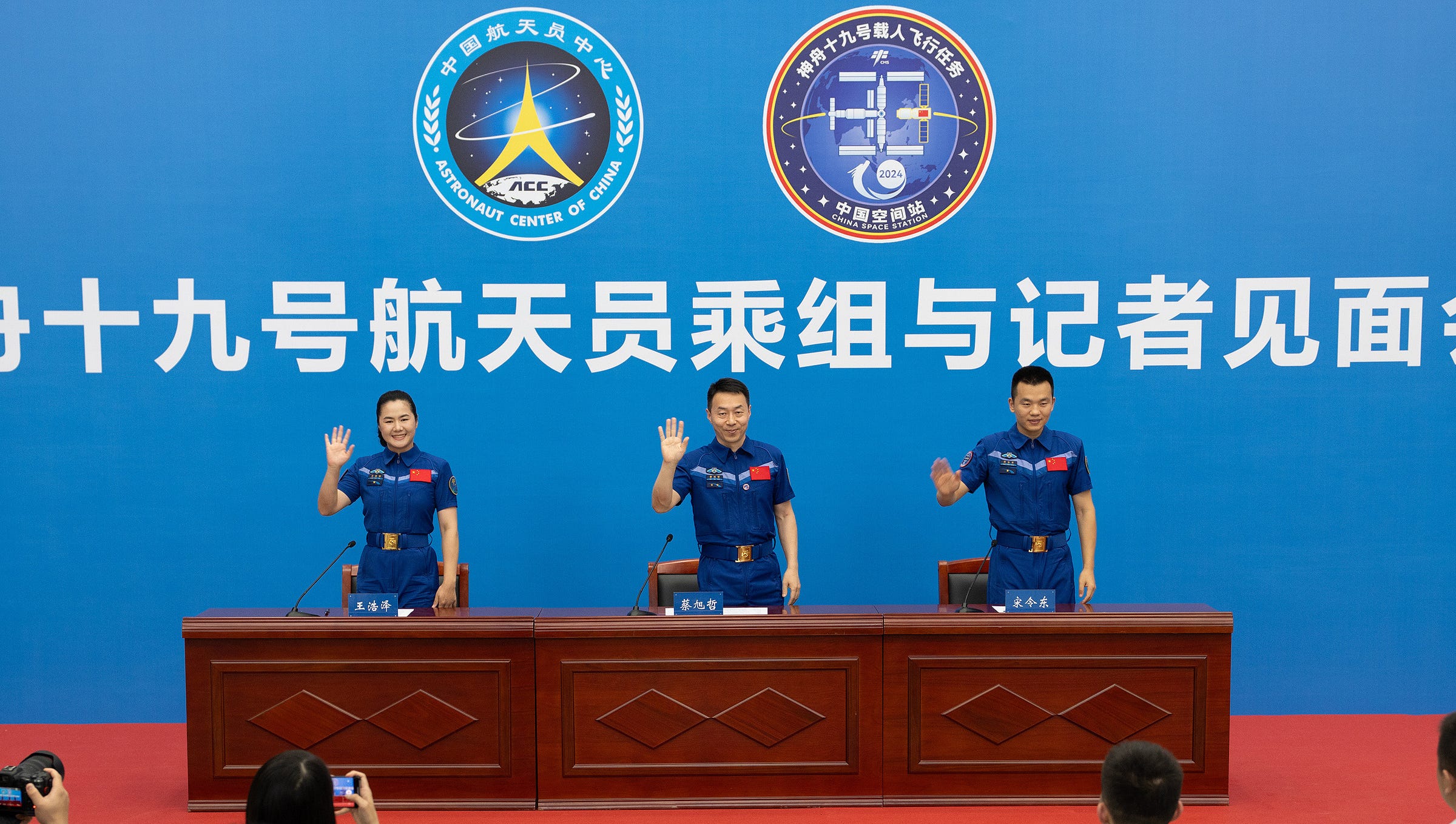
Cai Xuzhe (蔡旭哲), Wang Haoze (王浩泽), and Song Lingdong (宋令东) of the Shenzhou-19 mission to China’s Tiangong Space Station returned to Earth on April 30th after a six-month stay onboard. That saw the crew perform a record-length spacewalk alongside various experiments.
Over the past few months, the three taikonauts have had their physical and mental health monitored as their bodies readjust to the planet. Officials stated, via the Global Times, that the crew’s muscle strength, endurance, and cardiopulmonary functions have returned to preflight levels, and after passing health and well-being assessments in the coming weeks, they will re-enter potential selection for future missions and normal life.
As part of the process following post-mission health checks, the Shenzhou-19 trio met the press on July 9th for their first public appearance since their return. The meeting with the press touched on spacewalks, science experiments, and life on Tiangong.
An English transcript of the press conference has not been released, but a brief Chinese-language one has. As such, I’ve prepared an unofficial translation of the press conference, and it is provided below. Any errors present are my own, if you find any problems with this translation please reach out and correct me. If you are looking to reference any part of the transcript, please refer to the Chinese one posted by the China Manned Space Agency via its WeChat blog, or alternatively a copy posted by Our Space (我们的太空).
Transcript of Shenzhou-19 Crew Meeting with Journalists
Reporters: Commander Cai Xuzhе, you have now completed two flight missions and personally witnessed China's space station's leap from the construction phase to the application and development phase. What new feelings and experiences would you like to share with us?
Cai Xuzhе: Thank you for your question. First, on behalf of the Shenzhou-19 crew, I want to thank our media friends for accompanying us during our flight and for continuously following and reporting on our crew's work dynamics.
Each flight mission is not a simple repetition of the previous one, but a continuous leap to higher levels. During the Shenzhou-14 mission, we completed five dockings and nine configurations, witnessing in orbit the completion of the basic T-shaped configuration assembly of China's space station. After the mission's success, the Party Central Committee, State Council, and Central Military Commission honored me with titles, and I received congratulations from friends everywhere. All of this became powerful motivation for my next expedition and new achievements. With the dream of serving the motherland once again, I quickly threw myself wholeheartedly into the new selection and training process, preparing with all my strength for the new mission.
The Shenzhou-19 mission is the fourth crewed flight in the application and development phase of China's manned spaceflight program. We arranged 88 space science and technology experiments covering space life sciences, microgravity fundamental physics, space materials science, space medicine, and new space technologies. Our crew maintained zero mistakes and zero errors, striving to be the ‘eyes’ and ‘hands’ of researchers. We prepared over 102 experimental samples of more than ten types, completed on-orbit testing and verification of the space station pipeline inspection robot, laying the technical foundation for automatic pipeline detection; completed multiple tests including object weight perception, emotional state assessment capabilities, and replacement of experimental samples in the fluid physics experiment cabinet and high-temperature materials experiment cabinet, as well as projects involving fruit flies and intelligent assistants. Being able to make our own contribution makes us feel very happy. Now we can proudly say that we have not disappointed the wisdom, dedication, and hard work of the vast number of researchers. Thank you!
Reporters: Song Lingdong, the Shenzhou-19 crew's first spacewalk set a new record for the duration of taikonaut extravehicular activities, and you became China's first ‘post-90s’ taikonaut to perform a spacewalk. That first moment stepping outside must have been extraordinary. When you opened the hatch and, as a member of the ‘post-90s’ generation, took that historic step, leaving youthful footprints in the vast universe, what were your thoughts? Could you share with us?
Song Lingdong: With the vigorous development of manned spaceflight, more and more young people, more and more post-90s, are dedicating themselves to this cause. Under the guidance of our predecessors and with the support of all space workers, we continue to grow and gradually take on the mission of our generation.
So I think that post-90s performing spacewalk missions is both a mission given to us by our motherland and our generation's responsibility. This moment was bound to come, and it definitely would come.
Before the spacewalk, honestly, I had fantasized many times about the scene of going outside, wanting to see our beautiful Earth home and appreciate the magnificence of the universe. But when I actually opened the hatch and floated out, I was still shocked and deeply felt the profoundness and greatness of our cause. To execute the spacewalk mission well, the commander and I maintained high concentration during the extravehicular activity, striving for every operation to be precise. I climbed more than 100 handholds on the bulkhead, cooperating with the commander to stop at multiple positions. With the support of the robotic arm and ground personnel, after more than nine hours of extravehicular activity, we successfully completed tasks including installing space debris protection devices and inspecting and handling external equipment. After returning to the cabin, we were very proud and felt a great sense of achievement, completely forgetting the fatigue from the spacewalk.
Of course, dreams must be realized through struggle. To perform the spacewalk mission, we underwent scientific and rigorous training and preparation, day after day of training forges steel through repeated tempering. So I think the moment I opened the hatch was also my dream-fulfillment moment. Thank you.
Reporters: Wang Haoze, as China's first female space flight engineer, looking at the checklist of tasks you completed during this mission, how would you evaluate your space ‘debut’?
Wang Haoze: Thank you for your question. This mission was my first encounter with the universe. I still remember the strong sense of shock when I first entered our space home. The station was bright and clean, with precise and complex systems. At that moment, I felt sincere pride in our motherland and pride in being a space worker.
During this mission, our crew worked as one, with ground and space integrated, successfully completing three extravehicular activity tasks, multiple space science experimental tasks, station management, and supply management work. Before each operation, I told myself to slow down for safety and be meticulous for success. In space, to do the work well, you must be able to settle your mind and endure the grinding process. For example, with supply management work, you first need to have an overall grasp of all supplies throughout the station, then plan each supply management task, register every detail of every product. Only this way can you ensure the tasks are done precisely, orderly, and without error.
During the 183 days and nights in space, we wholeheartedly loved our space station, every module, every experiment, every piece of equipment. This is not only our home but also the ‘space home’ of thousands of space workers. I also look forward to returning to space soon, going back to our space home again, and once again writing glory and dreams across space!
Reporters: Commander Cai Xuzhе, according to reports, you created two records during your extravehicular activity activities. First, in this mission's first extravehicular activity, you set a world record for the longest single extravehicular activity duration by a spacewalker. Second, across your two flight missions, you performed a total of five extravehicular activities, becoming the Chinese taikonaut with the most extravehicular activities at that time. How do you view these two records? Also, from the Shenzhou-20 mission press conference, we learned that during the first extravehicular activity, you successfully handled an unexpected jamming problem with the cargo extravehicular activity payload adapter. Could you share the difficulties and challenges encountered in this process and how you overcame them?
Cai Xuzhе: During space station missions, an extravehicular activity is an extremely arduous task full of risks and challenges. For us taikonauts, this is heavy work and major work that tests not only our physical and psychological qualities but also our operational abilities and emergency response capabilities. Everyone sees us outside for just a few hours each time, but for each extravehicular activity, we undergo extremely arduous and complex training. Although we practice repeatedly on the ground, it doesn't become as natural in space as on Earth. So before extravehicular activity, we spend considerable time preparing suits, extravehicular activity products and tools, airlock supporting equipment, and debugging the space station robotic arm. We also complete on-orbit training and full-process rehearsals for each specific extravehicular activity mission. The smooth completion of each extravehicular activity task can be said to be the result of support from all research personnel, the result of crew unity and seamless ground-space cooperation, fully verifying the reliability of extravehicular activity suits and the space station robotic arm, demonstrating the maturity and confidence of our space technology. As taikonauts, we are just participants and executors. The honor belongs to all our space science and technology workers and to our great space cause.
Regarding handling the unexpected jamming of the external payload adapter, because we received the extravehicular activity disposal task on short notice, time was tight and the task was heavy. Moreover, we had no specialized tools at that time, and it involved the first time an taikonaut inside the cabin manually controlled the robotic arm's attitude. As you know, previously taikonauts operating the robotic arm controlled positions, but this time was the first time an taikonaut controlled the robotic arm's attitude. This was also a first for us. So after receiving the task, we did feel some pressure and worried that if we didn't handle it well during external disposal, it might cause further damage to external equipment. Facing this new challenge, during preparation, the ground team gave us very important support and help, providing detailed guidance and communication through bidirectional video calls between space and ground. On the day of extravehicular activity, we first made a preliminary assessment of the external adapter's condition, then communicated with the ground team based on our assessment. Through close ground-space coordination, we used improvised tools to handle the external payload adapter. After successful disposal, I heard enthusiastic applause from the ground through my earpiece, which made me feel inspired and encouraged, and also very proud. Proud of the taikonaut profession and proud of the leading role and value that taikonauts play in manned spaceflight.
Reporters: Song Lingdong, now the ‘post-90s’ generation has taken over the ‘flying to space’ relay baton from the ‘Shenzhou family’. Facing the sacred mission and the high expectations of predecessors, how do you become a ‘post-90s’ who can ‘shoulder responsibilities’? How do you inherit the manned spaceflight spirit in this great cause?
Song Lingdong: From the space station construction phase to the current application and development phase, we have experienced mission after mission, from seeing off teammates on expeditions to welcoming their triumphant returns. Behind each successful mission completion lies the dedication and hard work of countless space workers. We deeply understand that this path was forged by the older generation of space workers and supported by vast numbers of researchers. This is both a noble mission and supreme honor given to us by our motherland, as well as a heavy responsibility. We have no reason not to work hard, and even less reason not to shoulder responsibilities.
Space exploration is endless, and we will not forget our original intention, remember our mission, inherit the will and determination of our predecessors, and pass on and develop the manned spaceflight spirit. I also firmly believe that through the continuous struggle of generations of space workers, our ‘Shenzhou family’ will definitely reach deeper into space.
Reporters: Wang Haoze, what space science and application payload on-orbit experiments did you undertake? What were your gains?
Wang Haoze: Building ships is for establishing stations, and establishing stations is for applications. The on-orbit experiments of this mission covered space life sciences, microgravity fundamental physics, space materials science, space medicine, space new technologies, and other fields, carrying the wisdom, dedication, and hard work of many researchers.
We participated in implementing 88 space science experimental tasks and six payload entry-exit missions. About half of these experiments were new experiments conducted for the first time on the space station. Currently, all these projects have achieved phased results. I still remember under the joint care of space and ground, the fruit fly family achieved ‘three generations under one roof’ in space; during orbit, we also had intimate interactions with the intelligent assistant ‘Xiao Hang’; additionally, we tested and verified the space pipeline robot.
As a flight engineer, being able to personally experience the hard-won nature of scientific research, I especially treasured every experiment. We are not just operators of experiments but integrated ourselves into the entire research team, working hand in hand between space and ground, giving our all to do experiments to the best, not disappointing researchers' efforts and expectations. I also believe that under the efforts of generation after generation of space workers, our space science and technology will continue to break through and achieve more fruitful results. Thank you.
Reporters: Commander Cai Xuzhе, the crew stayed in orbit for 183 days with all work progressing smoothly. During orbit, what scheduled tasks did the crew complete? How did you manage to complete tasks so smoothly?
Cai Xuzhе: According to the overall arrangement, we completed three extravehicular activities, six cargo entry-exit missions, and multiple experimental research projects in various fields during orbit, many of which were implemented for the first time since entering the space station application and development phase. Additionally, we carried out spacecraft care, on-orbit training, maintenance and repair, and station management work. During the 183 days of orbital flight, our crew completed nearly 2,000 work items, with all work completed according to requirements and schedule. During orbit, we also spent traditional Chinese festivals like the Spring Festival and the Lantern Festival, and welcomed the visit of the Shenzhou-20 crew on the tenth China Space Day. We can say that Shenzhou-19 was a flight mission with very full work content and very special significance.
I think the mission's success came from both our crew's efforts and the escort and accompaniment of vast numbers of researchers. During the mission, our crew was united and worked closely together, especially teammates Wang and Song, who were energetic and enthusiastic, completing every task very well. I think the main reasons are based on three points: First, it's inseparable from solid training and crew teamwork. Facing some unplanned work adjustments and unexpected situations, our crew could remain calm and coordinate closely in response, benefiting from solid ground training and the tacit understanding cultivated through long-term crew interaction. Second, it's inseparable from full support from ground flight control personnel. Flight missions are never fought by the flight crew alone, crew unity and space-ground integration are our invincible formula. During mission execution, the ground team provided comprehensive, systematic, and effective support and guarantee. They are our most trustworthy and dependable teammates. Third, it's inseparable from the joint efforts of vast numbers of researchers. From product development to experimental research, from launch to return, every step we took and every operation we performed condensed the wisdom and sweat of countless researchers. Manned spaceflight is a great cause of ‘ten thousand people, one gun’, because of common beliefs, common goals, common ideals, and common responsibilities, we are united together, supporting us to realize our dream of flying to space and promoting the continuous development and progress of our country's manned spaceflight cause.
Reporters: Song Lingdong, through media broadcasts of on-orbit work footage, we saw that the vegetables in the space garden were growing well. What new harvests did you have?
Song Lingdong: You observed very carefully, and thank you for your attention to this cause. In this mission, we planted sweet potatoes in orbit for the first time, and they grew very well. Before returning, we sampled them according to ground personnel requirements and brought them back to Earth. They have now been handed over to our researchers, who are currently verifying the feasibility of using sweet potatoes as a food source for future medium and long-term flights.
Actually, growing vegetables in space is not only an experiment and work but also a very stress-relieving process. We planted sweet potato seeds, carefully tended them as they grew, and recorded in detail their entire process from germination to harvest. Actually, before sampling, I was still somewhat anxious because I didn't know what they had grown into, but when we opened the cultivation cup, they gave us a big surprise. The sweet potato tubers were very plump, and we felt very accomplished. Before parting with the Shenzhou-20 crew, we passed on this hope and joy, giving them two sweet potato seedlings we had propagated. According to my understanding, these two cups of sweet potatoes are currently growing very well.
Reporters: Wang Haoze, as a female taikonaut, how did you leverage your advantages on the space station? Also, you shared a small poem from training before the flight. After half a year of life, do you have any new works to share with us?
Wang Haoze: As a female taikonaut, I need to fully leverage my advantages in missions. When teammates summarized and reviewed, they also mentioned that female engineers' delicate operational habits, scientific thinking methods, and gentle psychological foundation all injected new energy into the entire crew.
Additionally, despite the challenges in extravehicular activity tasks on-orbit training and robotic arm operations, I still completed the missions successfully with full confidence. Being able to contribute more to scientific exploration and let the world see more female grace makes all my efforts more meaningful.
This half-year ‘space business trip’ was rich, fulfilling, and memorably exciting. Unforgettable was that stunning glimpse of Earth during rocket ascent; unforgettable was the joy and excitement of seeing the motherland during flight; unforgettable was the reluctance to part with that starry sky outside the window before departure. In leisure time, I also enjoyed reading and writing space diaries. On World Book Day, our crew jointly wrote about the wonder of reading in space. Every bit and piece is unforgettable. Upon return, I wrote my inner expectations into a small poem. Here I'd like to share it with everyone:
‘Chasing Dreams in the Galaxy’
The universe is filled with stars
One by one, point by point
Just like the flames in my heart
Even though the path to the stars is mysterious and distant I believe
A single spark can start a prairie fire
I will definitely light more torches
To illuminate the deep space
Only because
In that distant starry sky
Lies my life's dream
Finally, I wish every striver in the new era to have dreams to pursue and dreams that can be achieved.
Once again, if you are looking to reference any part of the transcript, please refer to the Chinese-language version (or copy) posted by the China Manned Space Agency via its WeChat blog.
About the Shenzhou-19 crew
Cai Xuzhe (蔡旭哲)
The commander of the Shenzhou-19 mission is Cai Xuzhe, making his second trip to the space station. Cai Xuzhe's first flight was for the sixth-month Shenzhou-14 mission, lasting from June to December of 2022, this mission saw the Wentian and Mengtian modules dock as well as having the first crew handover, when the Shenzhou-15 crew arrived.
Cai is from Shenzhou (深州市), in Hebei province (河北), and has served in the People's Liberation Army Air Force. In 2010 he was selected as part of the second group of taikonauts. After the Shenzhou-14 mission, Cai was awarded the honorary title of "Heroic Astronaut" in March 2023.
Wang Haoze (王浩泽)
The science operator for the Shenzhou-19 mission is Wang Haoze, making her first trip to space. Wang Haoze is part of the third group of Taikonauts and was selected in 2020.
Wang is from Chengde (承德市), in Hebei province (河北), and was previously a senior engineer at the Academy of Aerospace Propulsion Technology under the China Aerospace Science and Technology Corporation. During her time working as a propulsion engineer, she notably co-authored a paper about nuclear thermal rocket engines.
Song Lingdong (宋令东)
The operator for the Shenzhou-19 mission is Song Lingdong, making his first trip to space. Like his crewmate, Song Lingdong is part of the third group of Taikonauts and was selected in 2020.
Song is from Caoxian county (曹县), in Shandong Province (山东), and has served in the People's Liberation Army Air Force. Having joined the PLAAF in 2008, Song went on to earn the rank of Lieutenant Colonel along with flying Sukhoi Su-27 and Su-35 aircraft for international joint exercises.



